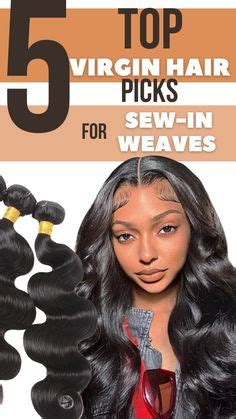Introduction
Hair extensions have become a popular way to transform your look, add volume, and achieve the hair of your dreams. Sew-in hair extensions are a versatile and long-lasting option that can give you beautiful, natural-looking results. In this comprehensive guide, we will delve into everything you need to know about hair for sew in, from choosing the right type to installing and maintaining your weave.

Benefits of Sew-In Hair Extensions
- Length and Volume: Sew-in extensions allow you to add length and volume to your natural hair, creating a dramatic or subtle transformation depending on your desired look.
- Versatility: Sew-in extensions can be styled in various ways, including braids, buns, ponytails, and updos, giving you endless styling possibilities.
- Natural Appearance: When installed correctly, sew-in extensions blend seamlessly with your natural hair, creating a natural and undetectable result.
- Long-Lasting: Sew-in extensions can last for up to 12 weeks, providing you with months of beautiful hair without the need for frequent re-installation.
Types of Hair for Sew In
The type of hair you choose for your sew-in will significantly impact the look and longevity of your weave. Here are the main types of hair available:
- Human Hair: Human hair extensions are the most natural-looking and expensive option. They can be styled and dyed just like your own hair and have a longer lifespan than synthetic hair.
- Synthetic Hair: Synthetic hair extensions are more affordable than human hair and come in a wide range of colors and styles. However, they are less durable and cannot be styled with heat tools.
- Virgin Hair: Virgin hair is human hair that has not been chemically processed or dyed. It is the most expensive type of hair but also the highest quality, providing the most natural-looking results.
Choosing the Right Hair for Sew In
Selecting the right hair for your sew in depends on your individual needs and preferences. Consider the following factors when making your choice:
- Budget: Human hair extensions are typically more expensive than synthetic hair.
- Hair Type: Match the texture of your hair extensions to your natural hair for a seamless blend.
- Desired Look: Determine what length, volume, and style you want to achieve.
- Lifestyle: Consider your lifestyle and how often you will style or manipulate your hair.
Installation Process for Sew-In Extensions
Installing sew-in hair extensions requires a professional hair stylist. Here is a step-by-step guide to the process:
- Preparation: Your hair will be washed, detangled, and dried before the installation.
- Sectioning: Your stylist will divide your hair into small sections, creating tracks for the extensions.
- Cornrows: Cornrows will be braided along each track to provide a secure base for the extensions.
- Sewing: The hair extensions will be sewn onto the cornrows, one bundle at a time.
- Blending: The stylist will blend the extensions with your natural hair to create a seamless transition.
- Styling: Once the extensions are installed, your stylist will style your hair to your desired look.
Maintenance Tips for Sew-In Extensions
Proper maintenance is crucial to extend the lifespan of your sew-in extensions. Follow these tips:
- Wash Gently: Use a sulfate-free shampoo and conditioner and wash your hair gently with your fingers or a soft brush.
- Detangle Regularly: Brush your hair daily with a wide-tooth comb to prevent tangles and breakage.
- Avoid Heat: Limit the use of heat tools on your extensions to prevent damage.
- Sleep with Care: Wear a satin or silk scarf or bonnet at night to protect your extensions from tangles and friction.
- Professional Maintenance: Visit your stylist regularly for trims, washes, and adjustments to keep your extensions looking their best.
Troubleshooting Common Problems
- Shedding: Some shedding is normal, but excessive shedding can indicate improper installation or damage.
- Tangles: Tangles can be caused by friction with bedding or improper brushing.
- Itching: Itching can occur if the extensions are too tight or the scalp is irritated.
- Breakage: Breakage can occur due to excessive tension or over-styling.
- Discomfort: If your extensions are causing pain or discomfort, adjust the tightness or consult your stylist.
Conclusion
Hair for sew in offers a versatile and long-lasting way to transform your look. By choosing the right type of hair, following proper installation techniques, and maintaining your extensions with care, you can enjoy beautiful, natural-looking hair for months to come. With endless styling possibilities and the ability to achieve your desired length and volume, sew-in hair extensions are the perfect solution for those looking to make a statement with their hair.
Frequently Asked Questions
-
Q: How long do sew-in extensions last?
- A: Sew-in extensions can last for up to 12 weeks with proper care and maintenance.
-
Q: How much do sew-in extensions cost?
- A: The cost of sew-in extensions varies depending on the type of hair, length, and complexity of the installation. On average, expect to pay between $500-$2,000.
-
Q: Can I wash my hair with sew-in extensions?
- A: Yes, you can wash your hair with sew-in extensions, but use a sulfate-free shampoo and conditioner.
-
Q: How often should I get my sew-in extensions tightened?
- A: Your stylist will determine the frequency of tightening appointments based on your hair type and the tightness of the installation. Generally, every 4-6 weeks is recommended.
-
Q: Can I style my sew-in extensions with heat tools?
- A: You can style your sew-in extensions with heat tools, but limit the heat and use a heat protectant spray to prevent damage.
Additional Resources
- The Complete Guide to Sew-In Hair Extensions
- Sew-In Hair Extensions: Everything You Need to Know
- Sew-In Hair Extensions: Pros, Cons, and How to Care
